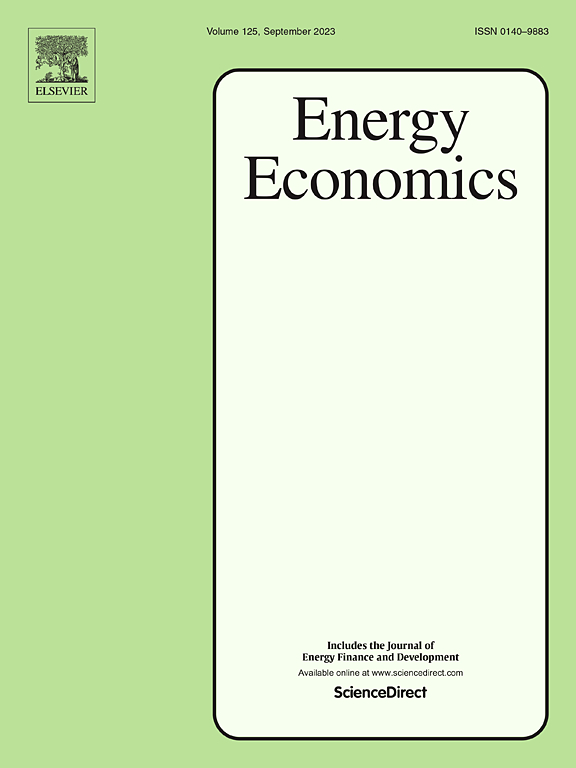国内太阳能光伏用户如何应对价格和温度冲击?2021-2022年间意大利的证据
IF 14.2
2区 经济学
Q1 ECONOMICS
引用次数: 0
摘要
可再生能源的使用、能源危机以及高温事件的频率和强度的增加正在改变欧洲家庭为获得热舒适而消耗能源服务的条件。利用2021年至2022年期间意大利北部一个城市10,000多户家庭的高频住宅用电量,我们发现太阳能光伏发电(PV)的采用在高价格和高温事件期间降低了电网用电量,提高了能源安全性和可负担性。我们使用全球碳社会成本(SCC)评估采用光伏的环境效益,以货币化避免温室气体排放造成的负外部性的价值。布雷西亚的普通家庭采用光伏每年可节省高达544公斤的二氧化碳,从而减少对环境的破坏,每年的价值为166 - 266欧元。此外,根据我们估计的需求函数,我们测量了有和没有光伏的家庭在价格引起的消费者剩余损失方面的显著差异,分别在133欧元和300欧元之间,突出了在价格波动期间采用光伏带来的巨大私人利益。我们的研究结果强调,有必要制定有针对性的政策,扩大住宅光伏系统的使用范围,不仅要支持气候目标,而且要通过保护脆弱家庭免受电价极端波动的影响来减轻能源贫困。本文章由计算机程序翻译,如有差异,请以英文原文为准。
How do domestic solar PV users respond to price and temperature shocks? Evidence from Italy between 2021–2022
The use of renewable energy sources, the energy crisis, and the increased frequency and intensity of high-heat events are changing the conditions under which European households consume energy services for their thermal comfort. Leveraging high-frequency residential electricity consumption from more than 10,000 households in a municipality in northern Italy between 2021 and 2022, we show that solar photovoltaics (PV) adoption reduces grid electricity consumption, during high-price and high-temperature events, enhancing energy security and affordability. We evaluate the environmental benefits of PV adoption using the global estimates of the Social Cost of Carbon (SCC) to monetize the value of avoided negative externalities due to GHG emissions. The adoption of PV by an average household in Brescia saves up to 544 kg of CO2 in a year, leading to a reduction of environmental damage for a value of €166–€266/year. Furthermore, based on our estimated demand functions, we measure significant differences in the loss of price-induced consumer surplus for households with and without PV, which amounts to between €133 and €300, respectively, highlighting substantial private benefits from PV adoption during price fluctuations. Our findings underscore the need for targeted policies that expand access to residential PV systems, not only to support climate goals but also to mitigate energy poverty by shielding vulnerable households from extreme fluctuations in electricity prices.
求助全文
通过发布文献求助,成功后即可免费获取论文全文。
去求助
来源期刊

Energy Economics
ECONOMICS-
CiteScore
18.60
自引率
12.50%
发文量
524
期刊介绍:
Energy Economics is a field journal that focuses on energy economics and energy finance. It covers various themes including the exploitation, conversion, and use of energy, markets for energy commodities and derivatives, regulation and taxation, forecasting, environment and climate, international trade, development, and monetary policy. The journal welcomes contributions that utilize diverse methods such as experiments, surveys, econometrics, decomposition, simulation models, equilibrium models, optimization models, and analytical models. It publishes a combination of papers employing different methods to explore a wide range of topics. The journal's replication policy encourages the submission of replication studies, wherein researchers reproduce and extend the key results of original studies while explaining any differences. Energy Economics is indexed and abstracted in several databases including Environmental Abstracts, Fuel and Energy Abstracts, Social Sciences Citation Index, GEOBASE, Social & Behavioral Sciences, Journal of Economic Literature, INSPEC, and more.
 求助内容:
求助内容: 应助结果提醒方式:
应助结果提醒方式:


